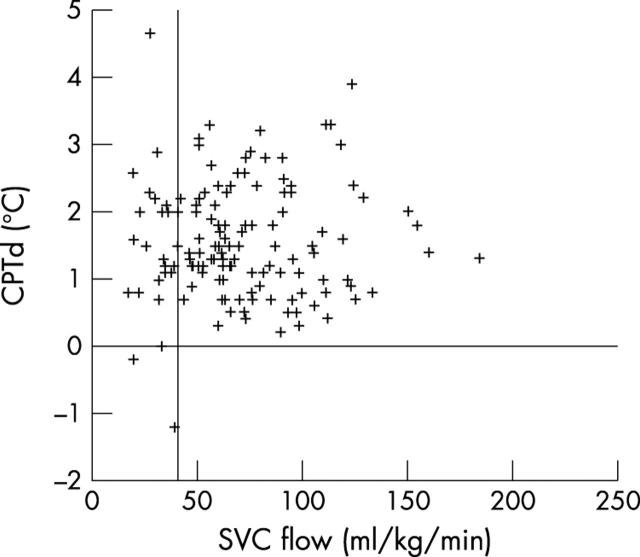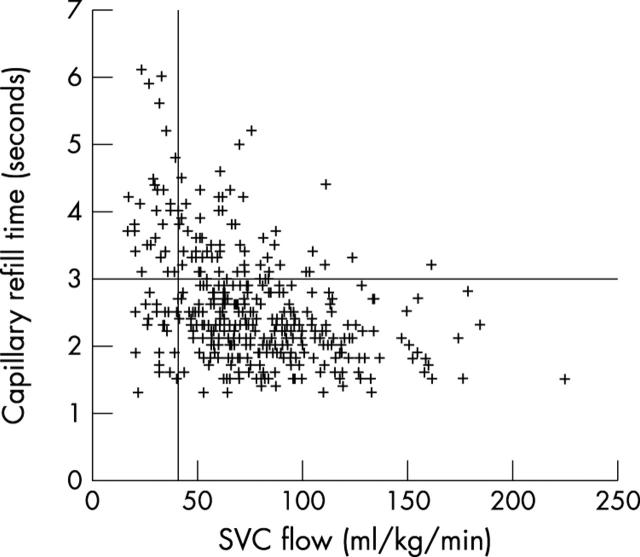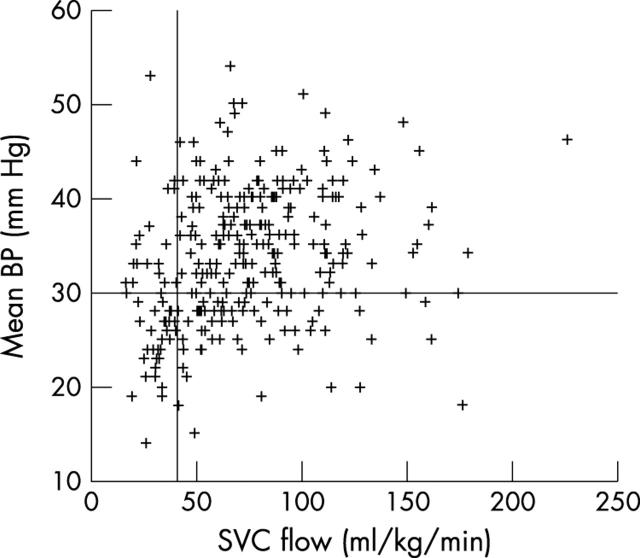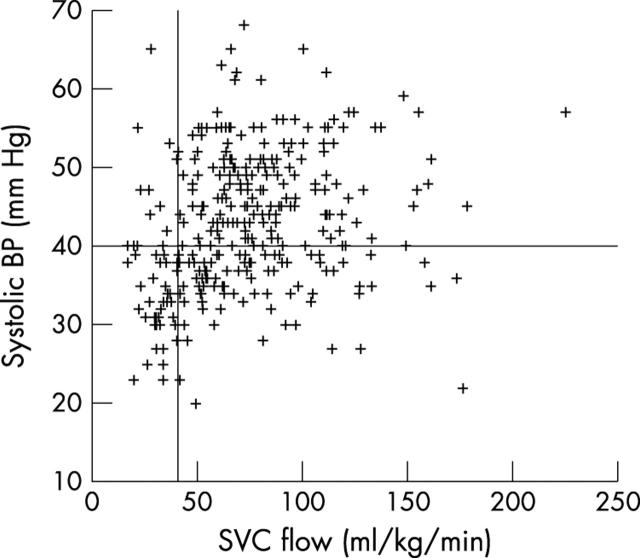Abstract
Objective: To determine the accuracy of blood pressure (BP), capillary refill time (CRT), and central-peripheral temperature difference (CPTd) for detecting low upper body blood flow in the first day after birth.
Methods: A prospective, two centre cohort study of 128 infants born at < 30 weeks gestation. Invasive BP (n = 108), CRT (n = 128), and CPTd (n = 46) were performed immediately before echocardiographic measurement of superior vena cava (SVC) flow at three, 5–10, and 24 hours after birth.
Results: Forty four (34%) infants had low SVC flow (< 41 ml/kg/min) in the first day, 13/122 (11%) at three hours, 39/126 (31%) at 5–10 hours, and 4/119 (3%) at 24 hours. CPTd did not detect infants with low flows. Combining all observations in the first 24 hours, CRT ⩾ 3 seconds had 55% sensitivity and 81% specificity, mean BP < 30 mm Hg had 59% sensitivity and 77% specificity, and systolic BP < 40 mm Hg had 76% sensitivity and 68% specificity for detecting low SVC flow. Combining a mean BP < 30 mm Hg and/or central CRT ⩾ 3 seconds increases the sensitivity to 78%.
Conclusions: Low upper body blood flow is common in the first day after birth and strongly associated with peri/intraventricular haemorrhage. BP and CRT are imperfect bedside tests for detecting low blood flow in the first day after birth.
Full Text
The Full Text of this article is available as a PDF (274.5 KB).
Figure 1 .
Scatter plot of central-peripheral temperature difference (CPTd) against superior vena cava (SVC) flow for all observations. Reference lines represent SVC flow of 41 ml/kg/min and zero CPTd.
Figure 2 .
Scatter plot of capillary refill time against superior vena cava (SVC) flow for all observations. Reference lines represent SVC flow of 41 ml/kg/min and capillary refill time of three seconds.
Figure 3 .
Scatter plot of mean blood pressure (BP) against superior vena cava (SVC) flow for all observations. Reference lines represent SVC flow of 41 ml/kg/min and mean BP of 30 mm Hg.
Figure 4 .
Scatter plot of systolic blood pressure (BP) against superior vena cava (SVC) flow for all observations. Reference lines represent SVC flow of 41 ml/kg/min and systolic BP of 40 mm Hg.
Selected References
These references are in PubMed. This may not be the complete list of references from this article.
- Bourchier D., Weston P. J. Randomised trial of dopamine compared with hydrocortisone for the treatment of hypotensive very low birthweight infants. Arch Dis Child Fetal Neonatal Ed. 1997 May;76(3):F174–F178. doi: 10.1136/fn.76.3.f174. [DOI] [PMC free article] [PubMed] [Google Scholar]
- Dollberg S., Rimon A., Atherton H. D., Hoath S. B. Continuous measurement of core body temperature in preterm infants. Am J Perinatol. 2000;17(5):257–264. doi: 10.1055/s-2000-10008. [DOI] [PubMed] [Google Scholar]
- Emery E. F., Greenough A., Gamsu H. R. Randomised controlled trial of colloid infusions in hypotensive preterm infants. Arch Dis Child. 1992 Oct;67(10 Spec No):1185–1188. doi: 10.1136/adc.67.10_spec_no.1185. [DOI] [PMC free article] [PubMed] [Google Scholar]
- Evans N. Echocardiography on neonatal intensive care units in Australia and New Zealand. J Paediatr Child Health. 2000 Apr;36(2):169–171. doi: 10.1046/j.1440-1754.2000.00469.x. [DOI] [PubMed] [Google Scholar]
- Evans N., Iyer P. Assessment of ductus arteriosus shunt in preterm infants supported by mechanical ventilation: effect of interatrial shunting. J Pediatr. 1994 Nov;125(5 Pt 1):778–785. doi: 10.1016/s0022-3476(94)70078-8. [DOI] [PubMed] [Google Scholar]
- Evans N., Iyer P. Incompetence of the foramen ovale in preterm infants supported by mechanical ventilation. J Pediatr. 1994 Nov;125(5 Pt 1):786–792. doi: 10.1016/s0022-3476(94)70079-6. [DOI] [PubMed] [Google Scholar]
- Evans N., Kluckow M. Early determinants of right and left ventricular output in ventilated preterm infants. Arch Dis Child Fetal Neonatal Ed. 1996 Mar;74(2):F88–F94. doi: 10.1136/fn.74.2.f88. [DOI] [PMC free article] [PubMed] [Google Scholar]
- Evans N., Kluckow M. Early ductal shunting and intraventricular haemorrhage in ventilated preterm infants. Arch Dis Child Fetal Neonatal Ed. 1996 Nov;75(3):F183–F186. doi: 10.1136/fn.75.3.f183. [DOI] [PMC free article] [PubMed] [Google Scholar]
- Evans N., Kluckow M., Simmons M., Osborn D. Which to measure, systemic or organ blood flow? Middle cerebral artery and superior vena cava flow in very preterm infants. Arch Dis Child Fetal Neonatal Ed. 2002 Nov;87(3):F181–F184. doi: 10.1136/fn.87.3.F181. [DOI] [PMC free article] [PubMed] [Google Scholar]
- Gill A. B., Weindling A. M. Randomised controlled trial of plasma protein fraction versus dopamine in hypotensive very low birthweight infants. Arch Dis Child. 1993 Sep;69(3 Spec No):284–287. doi: 10.1136/adc.69.3_spec_no.284. [DOI] [PMC free article] [PubMed] [Google Scholar]
- Greenough A., Emery E. F. Randomized trial comparing dopamine and dobutamine in preterm infants. Eur J Pediatr. 1993 Nov;152(11):925–927. doi: 10.1007/BF01957532. [DOI] [PubMed] [Google Scholar]
- Hegyi T., Carbone M. T., Anwar M., Ostfeld B., Hiatt M., Koons A., Pinto-Martin J., Paneth N. Blood pressure ranges in premature infants. I. The first hours of life. J Pediatr. 1994 Apr;124(4):627–633. doi: 10.1016/s0022-3476(05)83146-4. [DOI] [PubMed] [Google Scholar]
- Hentschel R., Hensel D., Brune T., Rabe H., Jorch G. Impact on blood pressure and intestinal perfusion of dobutamine or dopamine in hypotensive preterm infants. Biol Neonate. 1995;68(5):318–324. doi: 10.1159/000244252. [DOI] [PubMed] [Google Scholar]
- Klarr J. M., Faix R. G., Pryce C. J., Bhatt-Mehta V. Randomized, blind trial of dopamine versus dobutamine for treatment of hypotension in preterm infants with respiratory distress syndrome. J Pediatr. 1994 Jul;125(1):117–122. doi: 10.1016/s0022-3476(94)70137-7. [DOI] [PubMed] [Google Scholar]
- Kluckow M., Evans N. Ductal shunting, high pulmonary blood flow, and pulmonary hemorrhage. J Pediatr. 2000 Jul;137(1):68–72. doi: 10.1067/mpd.2000.106569. [DOI] [PubMed] [Google Scholar]
- Kluckow M., Evans N. Early echocardiographic prediction of symptomatic patent ductus arteriosus in preterm infants undergoing mechanical ventilation. J Pediatr. 1995 Nov;127(5):774–779. doi: 10.1016/s0022-3476(95)70172-9. [DOI] [PubMed] [Google Scholar]
- Kluckow M., Evans N. Low superior vena cava flow and intraventricular haemorrhage in preterm infants. Arch Dis Child Fetal Neonatal Ed. 2000 May;82(3):F188–F194. doi: 10.1136/fn.82.3.F188. [DOI] [PMC free article] [PubMed] [Google Scholar]
- Kluckow M., Evans N. Low systemic blood flow and hyperkalemia in preterm infants. J Pediatr. 2001 Aug;139(2):227–232. doi: 10.1067/mpd.2001.115315. [DOI] [PubMed] [Google Scholar]
- Kluckow M., Evans N. Relationship between blood pressure and cardiac output in preterm infants requiring mechanical ventilation. J Pediatr. 1996 Oct;129(4):506–512. doi: 10.1016/s0022-3476(96)70114-2. [DOI] [PubMed] [Google Scholar]
- Kluckow M., Evans N. Superior vena cava flow in newborn infants: a novel marker of systemic blood flow. Arch Dis Child Fetal Neonatal Ed. 2000 May;82(3):F182–F187. doi: 10.1136/fn.82.3.F182. [DOI] [PMC free article] [PubMed] [Google Scholar]
- Lambert H. J., Baylis P. H., Coulthard M. G. Central-peripheral temperature difference, blood pressure, and arginine vasopressin in preterm neonates undergoing volume expansion. Arch Dis Child Fetal Neonatal Ed. 1998 Jan;78(1):F43–F45. doi: 10.1136/fn.78.1.f43. [DOI] [PMC free article] [PubMed] [Google Scholar]
- Lyon A. J., Pikaar M. E., Badger P., McIntosh N. Temperature control in very low birthweight infants during first five days of life. Arch Dis Child Fetal Neonatal Ed. 1997 Jan;76(1):F47–F50. doi: 10.1136/fn.76.1.f47. [DOI] [PMC free article] [PubMed] [Google Scholar]
- Meek J. H., Tyszczuk L., Elwell C. E., Wyatt J. S. Low cerebral blood flow is a risk factor for severe intraventricular haemorrhage. Arch Dis Child Fetal Neonatal Ed. 1999 Jul;81(1):F15–F18. doi: 10.1136/fn.81.1.f15. [DOI] [PMC free article] [PubMed] [Google Scholar]
- Miall-Allen V. M., de Vries L. S., Whitelaw A. G. Mean arterial blood pressure and neonatal cerebral lesions. Arch Dis Child. 1987 Oct;62(10):1068–1069. doi: 10.1136/adc.62.10.1068. [DOI] [PMC free article] [PubMed] [Google Scholar]
- Newcombe R. G. Interval estimation for the difference between independent proportions: comparison of eleven methods. Stat Med. 1998 Apr 30;17(8):873–890. doi: 10.1002/(sici)1097-0258(19980430)17:8<873::aid-sim779>3.0.co;2-i. [DOI] [PubMed] [Google Scholar]
- Osborn David A., Evans Nick, Kluckow Martin. Hemodynamic and antecedent risk factors of early and late periventricular/intraventricular hemorrhage in premature infants. Pediatrics. 2003 Jul;112(1 Pt 1):33–39. doi: 10.1542/peds.112.1.33. [DOI] [PubMed] [Google Scholar]
- Osborn David, Evans Nick, Kluckow Martin. Randomized trial of dobutamine versus dopamine in preterm infants with low systemic blood flow. J Pediatr. 2002 Feb;140(2):183–191. doi: 10.1067/mpd.2002.120834. [DOI] [PubMed] [Google Scholar]
- Pladys P., Wodey E., Beuchée A., Branger B., Bétrémieux P. Left ventricle output and mean arterial blood pressure in preterm infants during the 1st day of life. Eur J Pediatr. 1999 Oct;158(10):817–824. doi: 10.1007/s004310051213. [DOI] [PubMed] [Google Scholar]
- Raju N. V., Maisels M. J., Kring E., Schwarz-Warner L. Capillary refill time in the hands and feet of normal newborn infants. Clin Pediatr (Phila) 1999 Mar;38(3):139–144. doi: 10.1177/000992289903800303. [DOI] [PubMed] [Google Scholar]
- Rozé J. C., Tohier C., Maingueneau C., Lefèvre M., Mouzard A. Response to dobutamine and dopamine in the hypotensive very preterm infant. Arch Dis Child. 1993 Jul;69(1 Spec No):59–63. doi: 10.1136/adc.69.1_spec_no.59. [DOI] [PMC free article] [PubMed] [Google Scholar]
- Ruelas-Orozco G., Vargas-Origel A. Assessment of therapy for arterial hypotension in critically ill preterm infants. Am J Perinatol. 2000;17(2):95–99. doi: 10.1055/s-2000-9265. [DOI] [PubMed] [Google Scholar]
- So K. W., Fok T. F., Ng P. C., Wong W. W., Cheung K. L. Randomised controlled trial of colloid or crystalloid in hypotensive preterm infants. Arch Dis Child Fetal Neonatal Ed. 1997 Jan;76(1):F43–F46. doi: 10.1136/fn.76.1.f43. [DOI] [PMC free article] [PubMed] [Google Scholar]
- Tibby S. M., Hatherill M., Murdoch I. A. Capillary refill and core-peripheral temperature gap as indicators of haemodynamic status in paediatric intensive care patients. Arch Dis Child. 1999 Feb;80(2):163–166. doi: 10.1136/adc.80.2.163. [DOI] [PMC free article] [PubMed] [Google Scholar]
- Watkins A. M., West C. R., Cooke R. W. Blood pressure and cerebral haemorrhage and ischaemia in very low birthweight infants. Early Hum Dev. 1989 May;19(2):103–110. doi: 10.1016/0378-3782(89)90120-5. [DOI] [PubMed] [Google Scholar]






